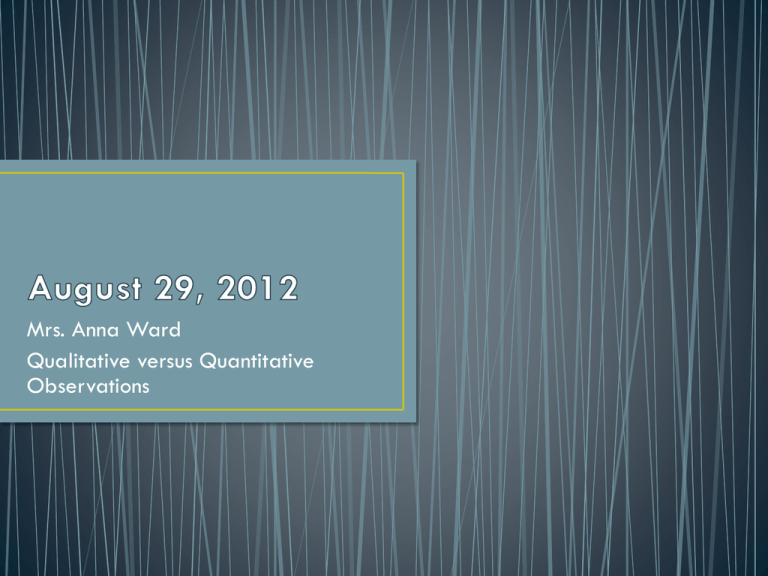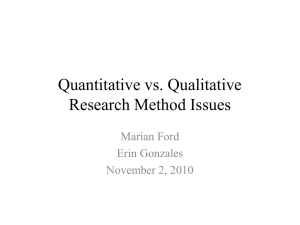Qualitative or Quantitative…
advertisement

Mrs. Anna Ward Qualitative versus Quantitative Observations • Come in QUIETLY and find your ASSIGNED seat quickly. • On your desk, you will find a sheet describing the differences between Qualitative and Quantitative Observations. • This Sheet will be attached into your science notebook, so take good care of it. • You should have your science notebooks today • FRIDAY— • Parent letters are due to your third block teacher • You need to have reading material for SSR during the morning time before the school day begins • You will have a quiz on classroom procedures • Review DO NOW!!! Sheets • Set up Science Notebooks • Short notes on Qualitative and Quantitative Observations • Review Collaborative Work Procedures • Lab on Sewer Fleas (OBSERVATIONS—Qualitative V. Quantitiative) •It is light green in color. •QUALITATIVE (1) •It tastes sour. •QUALITATIVE (1) •One leaf is 9 cm long. •QUANTITATIVE (2) •It makes a loud pop sound. •QUALITATIVE (1) •The mass of the computer is 1 ½ kg. •QUANTITATIVE (2) •It smells sweet. •QUALITATIVE (1) •The temperature of the room increases by 8 degrees C. •QUANTITATIVE (2) •It gets darker over a period of time. •QUALITATIVE (1) •The flowers cluster in 3 blooms. •QUANTITATIVE (2) •Feels very rough. •QUALITATIVE (1) •The Plant is short. •QUALITATIVE (1) •Leaves are stiff. •QUALITATIVE (1) •The veins are 3mm wide. •QUANTITATIVE (2) • What are some qualitative examples? • What are some quantitative examples? • Which type of observation is more accurate and why? •I will lead you through setting up your interactive science notebook. • GOING FORWARD, I have a special technique to help you know what is important and what you should write down. • Anything I need you to write down I will outline in RED. • Qualitative Observations are when you use your senses (sight, taste, smell, feeling and hearing) to note characteristics • QUALITATIVE QUALITY • EXAMPLES: odor, color, state of matter • Quantitative Observations are characteristics than can be measured • QUANTITATIVEQUANTITY (or amount) • Examples: density, mass, boiling point, melting point, length •You have been pre-assigned to groups based on your current seating. We are going to practice moving our desks in and out of groups.






